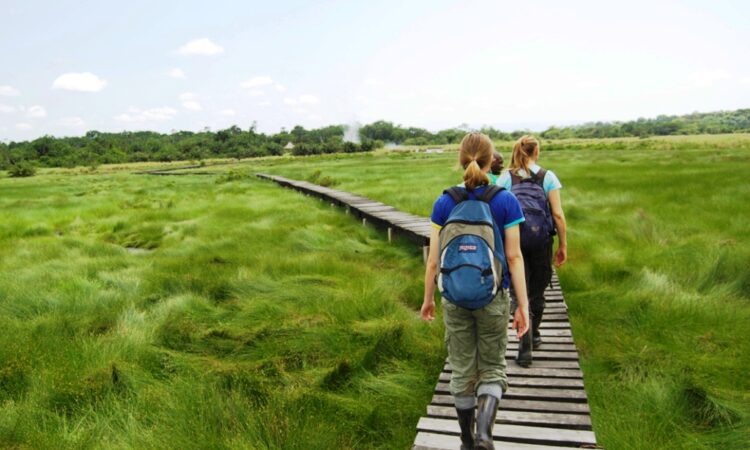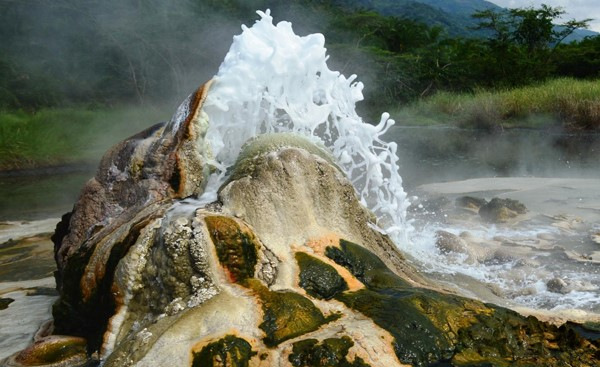Travel Guide to Toro Semliki Wildlife Reserve in Uganda : The Toro-Semliki Wildlife Reserve in western Uganda is mostly popular among birdwatchers. The reserve’s checklist is remarkable, with several birding specialties. The Albertine Rift Valley reserve is situated between the Rift Valley escarpment on the east, the Congolese Blue Mountains on the west, and the Rwenzoris on the southwest.

The major vegetation is woodland and savannah, and there are multiple rivers passing through, surrounded by riverine forest and sprinkled with patches of borassus palms. Other attractions include Sempaya’s hot springs and a Pygmy hamlet in the nearby Semuliki National Park, where the sole lodge offers a highly unique wilderness experience with guided activities.
Why visit Toro Semliki Wildlife Reserve?
Toro Semliki Wildlife Reserve Game Drive safari
Game drives in Uganda’s Toro Semliki Wildlife Reserve are an excellent chance to get up close and personal with animals like as chimpanzees, red-tailed monkeys, buffaloes, lions, and others. On rare occasions, tourists may see leopards and secretive bush babies during the day. Visitors may experience a range of ecosystems, including savannah woodland and riverine forests, on nature hikes across the reserve.
After nightfall, several nocturnal species, such the white-tailed mongoose, may be seen, while morning visits allow guests to feast their eyes on rainforests and savanna, producing both a magnificent environment and diversified ecosystem, aided by the Great Rift Valley’s Eastern escarpment.
Wildlife Found in Toro Semliki Wildlife Reserve
The park has a low density of wildlife species. Only the Uganda kob is widely distributed. All wildlife is wary and difficult to approach by automobile. Lions and hyenas are present but rarely seen; they are considerably more frequent to hear at night.
Elephants and buffalo are seldom seen. Leopards are occasionally sighted on night drives, although lions are more typically heard than seen. Many ape species, including chimps, live in the park, although interactions are rare.
Along the woodland paths, you may see grey-cheeked mangabey, black-and-white colobus, Central African red colobus, baboon, blue monkey, red-tailed monkey, de Brazza’s monkey, vervet monkey, and Dent’s mona monkey.
Birds
Uganda’s Toro-Semliki Wildlife Reserve may not be the finest place to see animals, but it is a birder’s delight. It has about 460 species documented in various environments. Lake Albert boat tours are perfect for seeing the elusive shoebill and a breeding colony of the magnificent red-throated bee-eater.
The nearby Semuliki National Park provides an excellent opportunity to add various Congolese rainforest species. From November to April, migratory birds are present. The Arrow-marked Babbler, Tropical Boubal, Black-headed Bushrike, Luhdrers Bushrike, Red-necked Falcon, Black-billed Barbet, the turkey-like Ground Hornbill, and Tropical Boubal are among the bird species.
Trees
Toro-Semliki is a forest-grassland mosaic with a mosaic of habitat and plant zones. The Wasa and Mugiri rivers, as well as their numerous tributaries, support 30-50m tall gallery forests in 50-250m broad areas inside the reserve. The Ugandan ironwood is the most frequent main canopy riverine tree species, followed by Millettia dura and Kigelia africana.
The understory is dominated by Beilschmiedia ugandensis, the most common tree in riverine woodlands. As visitors travel away from water sources, tree size decreases, sometimes gradually moving to open-habitat species like Acacia, Albizia, and bushy plants, but more often than not, the transition from forest to grassland is abrupt.
Other activities at Toro Semliki Wildlife Reserve
Other Ugandan activities that visitors to Toro Semliki Wildlife Reserve may look forward to on their vacation are as follows:
Birding: The birding at Toro Semliki Wildlife Reserve is spectacular all year, but it is at its peak in March, just after the relatively dry winter from December to February.
Sempaya hot springs: These incredible springs have temperatures of up to 100 degrees Celsius (212 degrees Fahrenheit), and the force, strength, and hotness of these springs demonstrate the strength of the geographical forces underneath.

Pygmy community in Semuliki National Park: Discover the Pygmy’s unique culture, traditions, and lifestyles as hunters and gatherers for centuries in a deep forest, part of the enormous Ituri Forest that spans into the Democratic Republic of the Congo.
Hiking to Nyaburogo Gorge: Hike via the 7km Nyabugogo Gorge route, which passes through a variety of ecosystems in the gorge, including open acacia-combretum forest and grassy grassland, as well as primate treks into the palm forest.
How to get to Toro Semliki Wildlife Reserve?
By Air
Most tourists to Uganda arrive by plane via Entebbe International Airport (EBB), and travelers should be informed of the most recent Uganda visa requirements. It is also feasible to travel to the airfield from Entebbe International Airport (EBB) or Kajjansi Airfield in Kampala by scheduled or chartered aircraft. Your tour operator will normally arrange for airport pickup and any necessary transport as part of your safari package.
By Road
The Toro-Semliki Wildlife Reserve in Uganda is roughly an hour’s drive from Fort Portal, the nearest settlement to Kibale National Park. The reserve is around 300 kilometers/180 miles from Kampala. The direct travel takes between 6 and 8 hours. Carrying a little quantity of local currency (UGX) is recommended for smaller transactions.
Weather and Climate in Toro Semliki Wildlife Reserve.
The climate of Toro-Semliki Wildlife Reserve is hot. These high temperatures are expected to last the entire year. The daytime temperature is approximately 30°C/86°F, while the nighttime temperature is around 18°C/64°F. Because there is no genuine dry season in Toro-Semliki, rain is unpredictable. However, there are two separate Wet seasons: March to May and August to November.
Best time to go
Understanding the optimum time to visit Uganda is critical since it affects lodging, flight pricing, availability, and the weather that travelers may expect on their safari holiday. Toro-Semliki Wildlife Reserve is best visited during the dry season. December to February and June to July are the two dry seasons. During the Wet Season (March to May and August to November), the roads become nearly impassable, and animal viewing drives are severely restricted.
How much is the Toro-Semliki Wildlife Reserve entrance fee?
For international adults, the admission cost to Toro-Semliki Wildlife Reserve is USD $35. Driving or strolling along the main road to Bundibugyo, which lies just beyond the park’s southeastern limit, is free of charge.
Accommodation at Toro-Semliki Wildlife Reserve
Tourists visiting Toro-Semliki Wildlife Reserve have a variety of alternatives for where to stay, with options ranging from luxury safari lodges to low-cost camping.
Lodges
Aramaga Rift Valley Lodge overlooks east Africa’s stunning Great Rift Valley, the Rwenzori Mountains, the Toro-Semliki Wildlife Reserve, the Congo’s Blue Mountains, and the edge of Lake Albert on clear days. The lodging includes stunning private pods, each with a 180-degree viewing glass to ensure visitors don’t miss a thing. Each of the six space-themed pods (Moonshot, Starship, Galactic, Orbit, Supernova, and Gravity) was created to capitalize on the stunning vistas and natural curves of the environment to provide private experiences with a casual attitude to luxury.
A fantastic option is the Semliki Safari Lodge, a luxury safari lodge that guarantees visitors complete solitude and seclusion while exploring the reserve’s many habitats, which range from tropical rainforest to wide grassland plains to wetlands and Lake Albert.
This lovely resort can only accommodate 16 guests in eight luxurious en-suite safari tents. Each is tastefully fitted, ensuring seclusion as well as spectacular rift valley views. There is also a major sitting space made entirely of natural materials like wood, stone, and thatch, as well as a peaceful swimming pool.
Camping
Along the banks of Lake Albert Ntoroko, the Uganda Wildlife Authority (UWA) operates a campground and cheap bandas (huts). Visitors can also stay in Semliki Safari Lodge, Ntoroko Game Lodge, or the headquarters in Karugutu, or at the Ntoroko landing site.
The Semliki Wildlife Reserve is located in the Western Region of Uganda, with its headquarters at Karugutu, Ntoroko District. Tours of the park may be paired with visits to Bwindi Impenetrable Forest National Park and Murchison Falls National Park.
In summary; The reserve is sometimes mistaken with the Semuliki National Park, which is located 10 km to the southwest. The mistake is unfortunate since, despite their close vicinity, the environments are vastly different; Toro Semliki Wildlife Reserve in Uganda is mostly grassland, whereas Semuliki National Park is mostly rainforest.


